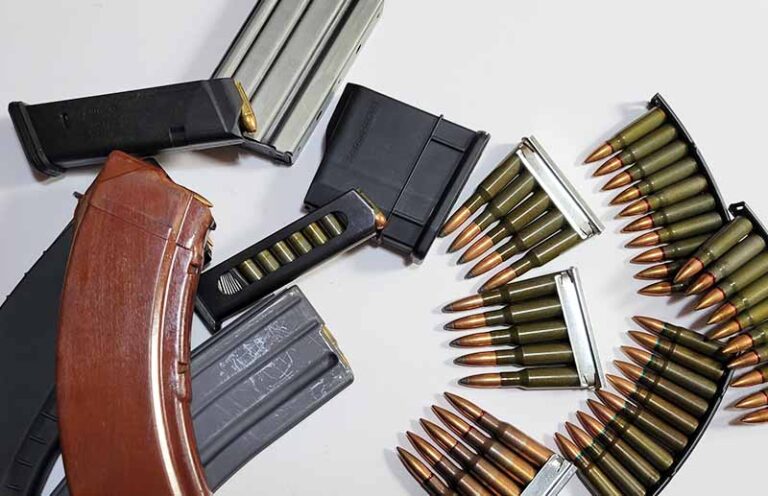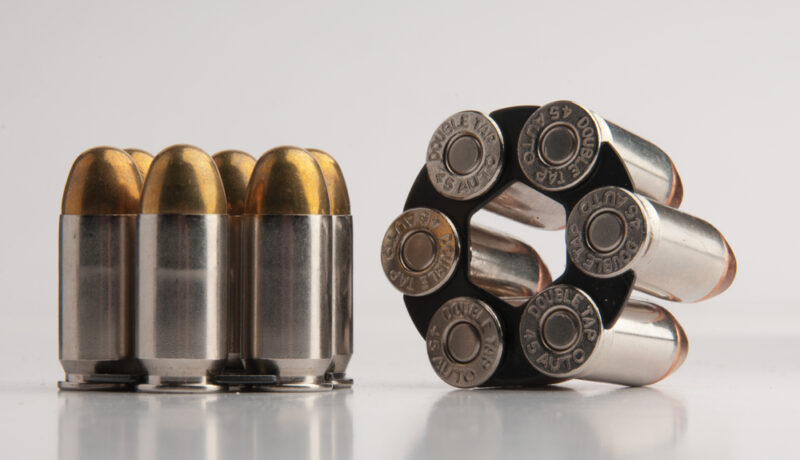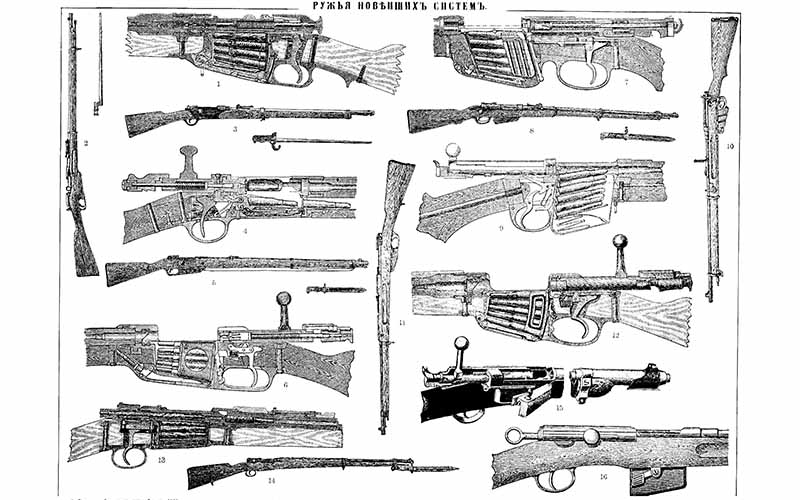
Yes, definitions matter, but when it comes to the ancient debate of clip vs. magazine, it’s not worth getting pedantic over.
One of the oldest henpecks in the gun community is “clip vs. magazine.” While there is a technical difference—which we're going to cover for anyone who might stumble across this and not know—it's also one of the most tired tropes around anything related to guns and shooting.

Clip Vs. Magazine: What's The Difference?
To get it out of the way, let’s describe what differentiates a firearm clip from a magazine in the simplest terms possible:
A clip is a literal clip that holds multiple cartridges together. There are a few different types, but all are used for loading ammunition into a magazine or a revolver’s cylinder. Clips do not feature a spring or any other means of feeding ammunition themselves.

A magazine is a mechanism that not only holds ammunition but feeds it into the firearm as well, typically via a spring. Some magazines are a permanent part of the gun (integral), while others are detachable and can be inserted and removed.

The word magazine comes to us from French (magasin) by way of the Arabic word (makhazin), meaning storehouse. This was first adopted as the word for ammunition storage areas for artillery before eventually being used for small arms as well.
As mentioned, one of the defining characteristics of a magazine is its ability to feed cartridges into a gun’s firing mechanism. They typically do this by using a spring to push a follower, a piece of metal or polymer, that then pushes the cartridges into the gun. The most common styles are boxes, drums and tubes, but other types exist as well.

There are also three different types of clips to be aware of.
Stripper clips, also known as chargers or charger clips, are essentially just speedloaders designed for feeding magazines. Stripper clips hold cartridges in a stack, and the user loads them into a magazine by placing the clip in a guide notch and pressing the ammunition down. Once all rounds have been loaded into the magazine, the clip has served its purpose and can be discarded.
While stripper clips are merely used to hold cartridges together until they’ve been stripped into a magazine, en bloc clips retain their usefulness for a bit longer. That is because en bloc clips are inserted into the magazine themselves, along with the ammo they’re holding. The most iconic example of this type is doubtlessly the M1 Garand.

The third type of clip to be aware of is the moon clip, something only used by certain revolvers, most commonly those chambered for rimless cartridges like .45 ACP or 9mm. Moon clip revolvers aren’t very widespread, but of those that use them, their cylinders are specially machined to accommodate the clip when the cylinder is closed. The clips hold the ammunition (either all rounds in a full-moon clip, or less in a half-moon clip), and are then inserted into the cylinder. Because the rounds are linked, hitting the ejector rod will kick the whole clip out.

Clip Vs. Magazine: Historical Context
So, to understand why the words clip and magazine are often used interchangeably, we must first understand how both devices have been used by people over time.
The first magazines were tubular magazines, but by the mid-19th century integral box magazines were being developed as well. The impetus for this invention was to allow the then-new pointed (spitzer) bullets to be used without them detonating each other’s primers (as was the case in tube magazines).

These integral box magazines quickly became the standard for the world’s service rifles, and that remained true throughout WWII. Even early rifles that featured detachable box mags, such as the Lee-Enfield, were intended to be reloaded via stripper clip. For the first half of the 20th century, only semi-auto handguns, submachine guns and machine guns commonly used detachable box magazines, and these were mostly limited to military use. Rifles with detachable magazines were available on the commercial market, such as the Winchester Model 1907, but they weren’t nearly as popular.
Remember, too, that revolvers were far and away the most popular handgun style until the last quarter of the 20th century. While commercial semi-autos certainly existed, far more people were buying wheelguns than, say, 1911s or Browning Hi Powers.
But how does this have any bearing on the words that people use?
Colloquially, the word “clip” had a much stronger association with the act of loading a firearm in the early- to mid-20th century than it did with the device itself. This of course passed into the general lexicon. During this period, “magazine” would have more commonly referred to the integral tube magazine on a lever-action rifle or pump-action shotgun, not the detachable box magazine of something like an M1 Carbine.
This phenomenon was further reinforced by its use in less colloquial, more official mediums such as this Colt advertisement from 1969. When even Colt refers to magazines as clips, what do you expect Joe Schmo to call them? Of course, media like films and games contributed to this as well.

The trend has persisted through today, and many still prefer to call their magazines clips. Given the historical context, however, it’s easy to see why. On the surface, both clips and magazines load ammunition into a firearm, and for the layman, any difference beyond that doesn’t really matter. A stripper clip for an SKS and a PMAG for an AR-15 functionally do the same thing. The predominance of clip-based over detachable magazine-based firearms for a good chunk of the early 20th century ensured that “clip” remained in the collective vocabulary long after detachable magazines overshadowed their use.
Will The Last Person Correcting People On This Turn The Lights Off?
On the one hand, it's true that words have definitions. One must be precise in their diction to prevent being misunderstood. Accuracy matters, not only in marksmanship.
On the other hand, it's also true that—at best—correcting people over “clip vs. magazine” is pedantic. It can even be worse than useless.
Other “gun people” (or whatever phrase you like to use) already know the difference, and there's no use in preaching to the converted. Those who aren't aware probably don't care, and also don't care that you do, so getting tripped up over semantics probably won’t win you any friends.

Thankfully, this trope—which can be found in the comments sections of various gun websites and social media channels—seems to be dying. It's not as common to hear or see anyone saying, “It's a magazine, not a clip!” anymore.
It's also worth mentioning that very few firearms that use clips are currently in production, and virtually all of those are revolvers. The word clip, at least according to its actual definition, is falling out of common use as a result. It probably won’t be long until magazine naturally becomes the more commonly used word without any outside intervention.
So, the next time you feel the urge to correct someone over this point, take a deep breath and remember that it’s probably not worth it. Instead, why don’t you invite them to the range, load some “clips” into your AR and just have a good time?
More On Mags And Clips:
- 7.62 AK Mags :What You Need To Know
- The 7.62×39 AR Magazine Buyer's Guide
- Mag Pump: The Thumb Saver
- M1 Garand En Bloc Clip Tips

Next Step: Get your FREE Printable Target Pack
Enhance your shooting precision with our 62 MOA Targets, perfect for rifles and handguns. Crafted in collaboration with Storm Tactical for accuracy and versatility.
Subscribe to the Gun Digest email newsletter and get your downloadable target pack sent straight to your inbox. Stay updated with the latest firearms info in the industry.

![Best Concealed Carry Guns In 2025 [Field Tested] Wilson Combat EDC X9S 1](https://gundigest.com/wp-content/uploads/Wilson-Combat-EDC-X9S-1-324x160.jpg)


![Best 9mm Carbine: Affordable PCCs [Tested] Ruger Carbine Shooting](https://gundigest.com/wp-content/uploads/Ruger-Carbine-Shooting-100x70.jpg)
![Best AR-15: Top Options Available Today [Field Tested] Harrington and Richardson PSA XM177E2 feature](https://gundigest.com/wp-content/uploads/Harrington-and-Richardson-PSA-XM177E2-feature-100x70.jpg)

Since I am not a firearms expert, thanks for the information. It was educational. Now I know the difference between the various types of magazines and clips.
Words matter. I can define “WOMAN” and I know the difference between clip and magazine. So should any gun owner.
Nomenclature is a good indicator of someone’s seriousness and commitment to factual accuracy. In my long experience people who call mags “clips” are usually spreaders of other, more harmful and ridiculous fuddlore.
Words used to have meaning. (See: gun violence, assault weapon, full-semi-auto, a gun’s bullet capacity).
Without agreed upon meanings, why bother to use words at all.
Rick – you nailed it – words – and their definitions – DO mean something. Ambiguous terminology is largely to blame for the antis controlling far too muck of the discussion, and not just about firearms. “What is a woman” – Sam can call me pedantic or simply just stubborn but I will still insist on using proper terminology.
It really is as simple as that. Well said, GomeznSA!